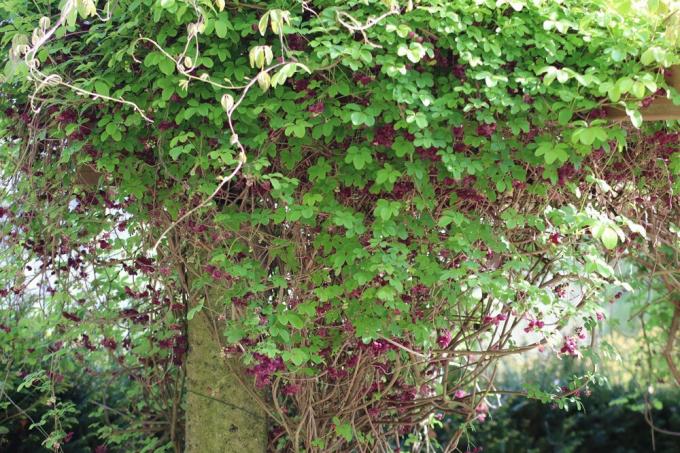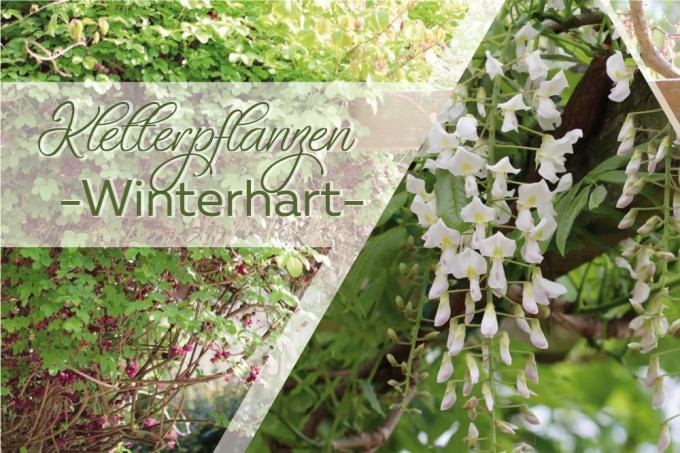
table of contents
- Hardy climbing plants
- Full sun
- Sun and partial shade
In the world of climbing plants, there is no room for dreary facades, empty climbing arches or desolate pergolas. With dense leaves and lavish abundance of flowers, the floral acrobats climb the climbing aids provided or manage the ascent on their own. The protagonists among the tireless climbers do not allow themselves to be prevented from their task by the freezing frost, because they are completely hardy. Explore a selection of popular species and varieties here. These 10 climbing plants bloom for several years.
Hardy climbing plants
Full sun
Species and cultivars for full sun locations - list of sun worshipers
On the south side of the house and garden, sun worshipers feel in good hands under the climbing plants. The most hours of sunshine can be found here in every season, sparking a lavish flower festival. In order to withstand the associated heat development in midsummer, climbers with good grades are in demand. So that
floral acrobats blooming perennial, it is not enough that they are hardy. Short-term drought stress and scorching heat should also not cause problems for the plants. The following types and varieties are ideal for greening facades, pergolas, fences and arbors facing south.Climbing Roses (Rosa)
Climbing roses combine fairytale blooms with vital growth to green house walls, trellises and pergolas. Trellis or rope systems offer the thorny tendrils sufficient support. Some of the most beautiful varieties from the majestic rose family fulfill the task of a climber, preferably in full sunshine.
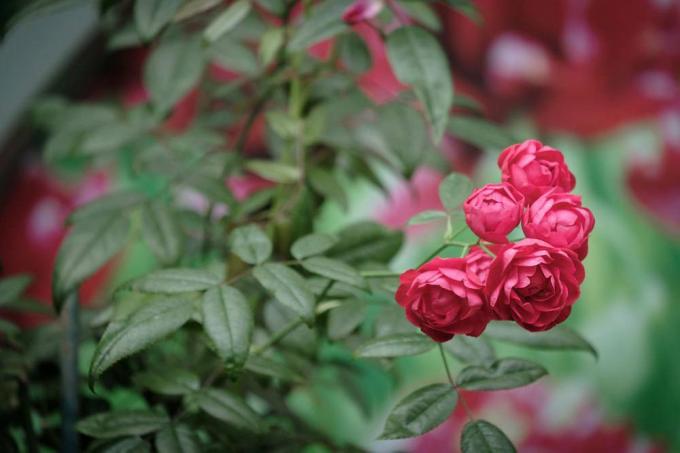
'Golden Gate'
- golden yellow, semi-double and gracefully frilled flowers from June to October
'Santana'
- fiery red flowers from June to September, extremely tolerant of heat
'Uetersener Klosterrose'
- cream-colored, semi-double flowers appear several times per season
'Jasmina'
- Abundantly blooming with double, violet-pink flowers from June to September
A novelty from the house of the famous German rose grower Kordes delights with opulent flowers, seductive fragrance and robust resistance to powdery mildew and blackened soot. The pure white Climbing rose 'Hella' was not only awarded the ADR rating, but also a gold medal due to its convincing attributes.
In the bee-friendly garden, gardeners prefer climbing roses with simple flowers. Filled rose petals are a feast for the eyes, but not a feast for bees. There is no food to harvest for bumblebees, bees and butterflies because the pollen-producing stamens have been converted into record leaves. Furthermore, nectar-producing organs are inoperable or, due to the dense petals, inaccessible to insects. So that climbing plants are not a sham for pollinator insects, varieties such as these are moving into focus creamy white 'Bobby James' or the pink 'Bonny'.
American climbing trumpet (Campsis radicans)
The American climbing trumpet has all the properties that gardeners want in climbing plants. Adhesive roots ensure a good hold on every climbing aid. A decorative foliage made of green pinnate leaves obscures unsightly masonry and sober fences. From July to October, colorful, up to 8 cm long trumpet blossoms sit enthroned above the leaves, which gather in dense clusters. The picturesque flower show repeats itself over a number of years, as the plants are well hardy. If the shoots should freeze back in freezing frost, that is not tragic. Just in time for the beginning of the warm season, the tendrils sprout again with fresh buds.
- Height: 600 to 1200 cm
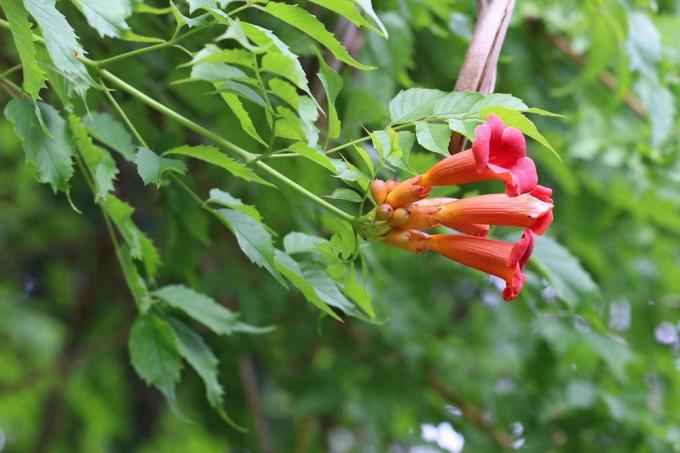
Japanese wisteria 'Blue Dream' (Wisteria floribunda)
One of the most vigorous climbing plants immigrated to Central Europe from Asia, and its breathtaking abundance of flowers inspires. Japanese wisteria conquers facades, fences and arches at a rapid rate of 70 to 150 cm per year. From May to July, imposing flower clusters with a length of up to 50 cm cast a spell on every observer. The sunnier the location, the more opulent the floral display. The enormous growth potential should not be underestimated. Stable climbing frames and regular pruning are essential to keep the growth rocket in check. Thanks to her Asian origins, the lush climbing artist has a robust frost resistance in her luggage, so that she blooms for several years.
- Height: 400 to 800 cm
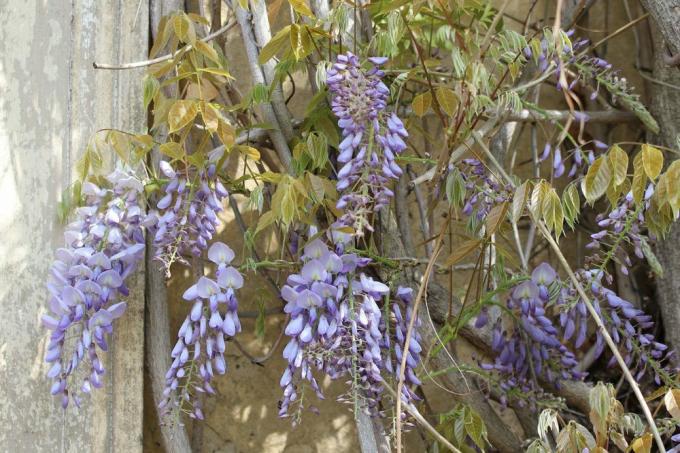
Sun and partial shade
Climbing plants for sunny to partially shaded locations
The vast majority of flowering climbing plants prefer a sunny to partially shaded location. In these locations the sun shines in the morning hours or in the late afternoon and early evening. These favorable lighting conditions are guaranteed on the west and east side of the house and garden or along a fence with north-south orientation. It should be at least 4 hours of sunshine a day during the growing season so that the climbers can put on their flower dress. The following species and varieties are hardy and bloom for several years in a sunny to partially shaded location.
Honeysuckle (Lonicera)
The honeysuckle genus gives us a colorful array of attractive climbing plants, all of which are hardy and bloom for several years. You have the choice between evergreen and deciduous species, different flowering times and beautiful flower colors. What they all have in common is the talent for climbing lofty heights, provided that a climbing aid is available. The following list presents recommended varieties with their outstanding attributes.

Repens
- white-yellow flowers from April to June
- evergreen foliage
- Height: 200-400 cm
Jelängerjelieber
- yellow-white-red-pink flowers from May to July and coral-red berries in autumn
- Height: 400-600 cm
Goldflame
- fragrant purple flowers with golden yellow inside from June to September
- Growth height 300-600 cm
The forests of Asia are home to an evergreen honeysuckle, which is also completely hardy north of the Alps. The wildly romantic species with the name Lonicera henryi sets itself in scene with yellow-red flowers from June to July and wears dark green leaves all year round.
Clematis
The queen of climbing plants should not be missing in this overview. The clematis truly deserves this title, as a look at the sea of blossoms shows, with which the climbing beauty from the house wall to the tree embellishes any climbing aid. The most important prerequisites for vital growth are a sunny location for the densely leafed tendrils and a shady foot. Clematis naturally have the appropriate frost hardiness for a sustained vitality. Let yourself be inspired by the following selection of legendary clematis varieties.
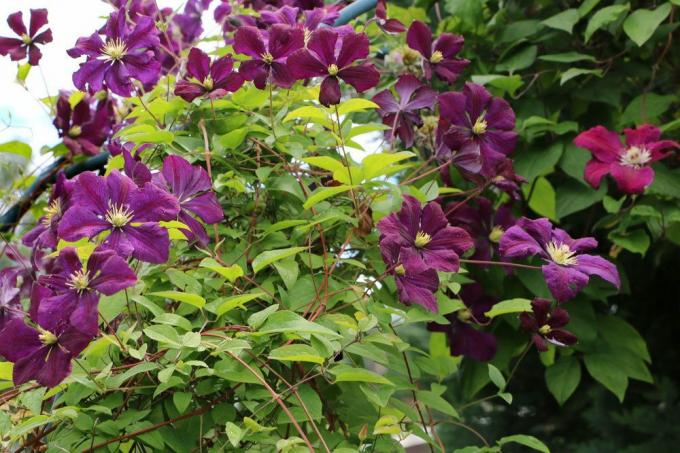
'Rubens'
- light pink cup-shaped flowers in May and June
- strong growth up to a height of 800 cm
'Madame Le Coultre'
- white, large-flowered clematis blooms from June to September
- Climbing height up to 300 cm
'The President'
- Classic with huge purple flowers from May to September
- Growth height up to 400 cm
'Purpurea Plena Elegans'
- late blooming from July to October with double, purple flowers
- up to 400 cm high
If you look out for the ideal clematis for socialization with climbing roses, the premium variety brings you 'Royal Velor' in the game. The velvety red, up to 10 cm large flowers harmonize wonderfully with double and simple rose petals. The long, common flowering time from June to October is another argument in favor of the creative union of both climbing plants.
We do not want to withhold clematis with restrained growth for cultivation in the tub with integrated climbing aid. The successful breeding 'Josephine' remains at a climbing height of 200 to 250 cm in order to present its double, multi-colored flowers. At the beginning of the flowering period in May, mauve-pink petals unfold. As the summer progresses, the color turns into an elegant purple. Until the end of the flowering period in September, dark pink stripes adorn the petals. Although all climbing clematis are hardy, cultivation in the tub requires light winter protection. The root ball is in an exposed position that makes it vulnerable to frost.
Climbing hydrangeas (Hydrangea anomala and Hydrangea petiolaris)
The greening of vertical surfaces is always a headache when there is a shortage of light at the location. Thanks to the climbing hydrangeas, problem-solving becomes a creative pleasure. Like all garden hydrangeas, hydrangea species with climbing tendrils prefer to flower in partial or light shade. As climbing plants, hydrangeas are particularly hardy and only freeze back in very severe frost. The following two varieties have emerged as recommendable in this regard.

'Semiola'
- Self-climbing with white flowers from June to August, evergreen foliage
- with a height of 250 to 300 cm
Hydrangea petiolaris
- strong growing species up to 600 cm in height
- with pure white cup flowers in June and July
Both climbing plants from the genus Hydrangea do without a climbing frame. With the help of their adhesive roots, climbing hydrangeas conquer walls, pergolas and trees in no time at all. This property can cause problems in facade greening because the adhesive organs grow into cracks in the wall. As a precaution, experts therefore recommend installing a rope system on house walls that keeps the tendrils at a distance.
Schling knotweed (Fallopia baldschuanica)
The climber among the climbing plants gains between 100 and 300 cm in height every year. Its frost hardiness reaches up to - 30 degrees Celsius at an advanced age. The white flower panicles therefore not only appear once from July to September, but also bloom for several years. The creeping plant species is nicknamed "Architect's rust" because under the dense foliage, optical defects in the masonry are concealed. Opinions differ with regard to the possible height. The information extends from 800 to 2000 cm.

Winter jasmine (Jasminum nudiflorum)
Winter flowering climbing plants are few and far between in the plant kingdom. The yellow flowers of winter jasmine cause a sensation in the middle of the cold season. In mild wine-growing regions, the yellow spots bloom from December to March. In climatically rougher locations, they still enjoy climbing aids up to a height of 300 cm from February to March. Gardening beginners appreciate that the climbing winter beauties thrive in any normal soil and also like to put themselves in the limelight in large tubs. Experts attest Jasminum nudiflorum a frost hardiness of - 17.7 degrees Celsius, so that the unique climbing plants bloom for several years in the protected location.

Chinese split basket (Schisandra chinensis)
The Chinese split basket is intended for gardeners with a weakness for rare climbing plants. The creeper has a long tradition in Asia because its pretty flowers turn into tasty and healthy berries. From May to June, white-pink flowers adorn the up to 600 cm high plant, underlined by 10 cm long, oval and shiny green ornamental leaves. A seductive fragrance heralds the Asian rarity from afar. The red berries can be harvested in September and October. They are called five-aroma fruit because they taste sweet, sour, hot, bitter and salty at the same time. The exotic appearance of Schisandra chinensis belies the fact that the plant is hardy and perennial.
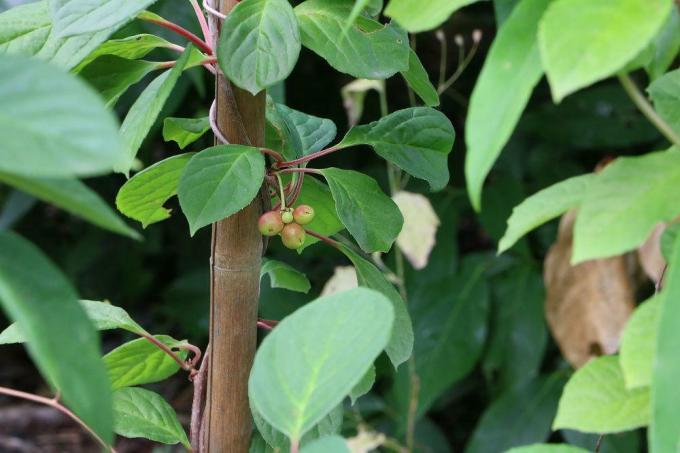
Finger-leaved climbing cucumber (Akebia quinata)
A feast for the senses ends this overview of hardy climbing plants. The tropical, woody climbing cucumber trumps with a variety of attributes. It owes its second name “chocolate wine” to the seductive scent of its red-brown female and pink male flowers, which appear from April to May. The palm-shaped leaves adorn the climbing plant without ceasing in mild winters. The combination of a dark green top and a blue-green bottom is decorative, which creates pretty effects in the wind. The whimsical, purple fruits not only add beautiful accents in autumn, they are also edible. A winter hardiness of up to - 20.6 degrees Celsius is remarkable, so that the tropical climbing plants bloom and fruit for several years north of the Alps.
- Height: 800 to 1200 cm
